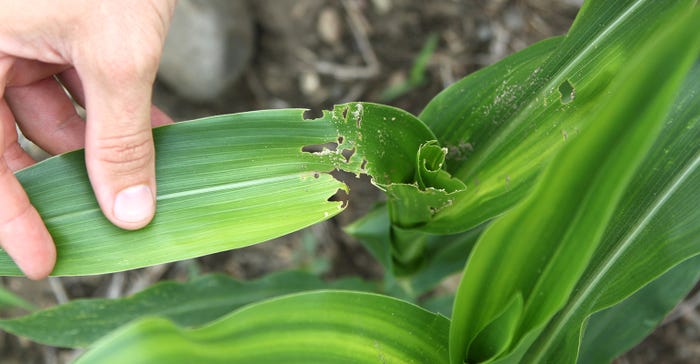March 24, 2017

Common stalk borer is an early-season pest of corn that requires watching. It’s native to South Dakota. Outbreaks are sporadic, but when common stalk borers are present in high numbers, they can cause significant yield loss, says Adam Varenhorst, South Dakota State University Extension entomologist.
Common stalk borer caterpillars injure corn when they tunnel into stalks of corn during the early vegetative growth stages. Damage typically occurs from emergence through about the V5 stage of the corn plant development. Infestations are typically observed in the first four to eight rows that are adjacent to grassy areas. Although caterpillars feed on corn leaves, stalk tunneling is the principal cause of yield loss. Stalk tunneling can delay corn development, resulting in deformed plants and reduced yields via poor pollination and smaller ears. If caterpillars feed on the growing point of the corn, they can cause a condition known as “dead heart,” where the corn plant will stop growing, wilt and eventually die.

FEEDING SIGNS: Leaf feeding injury in corn is associated with common stalk borer. (Photo by Adam Varenhorst)

As corn plants develop, they are more capable of tolerating common stalk borer infestations, and the caterpillars are less likely to feed on the growing point.
Management
There are Bt corn hybrids available that produce toxins that manage common stalk borer caterpillars. However, only the Bt toxin Vip3A is labeled for control of common stalk borer. The other Bt toxins, Cry1Ab and Cry1F, are labeled for suppressing common stalk borer, indicating that infestations may still occur.
Early planting reduces the risk of injury, too, as older plants are more capable of tolerating common stalk borer caterpillar feeding. Populations of common stalk borer are also reduced by burning grassy areas surrounding cornfields in late winter, when overwintering common stalk borer eggs are present on grasses and grasses can regrow the following spring.
Eggs typically begin to hatch at about 575 degree days, and the majority of eggs will finish hatching by about 750 degree days. Caterpillars begin moving from smaller grass host plants and into corn at about1,400 degree days, with 50% of common stalk borer caterpillars moving into corn at about 1,700 degree days.
Timely insecticide applications that target either newly hatched caterpillars or their migration from grasses to corn can effectively reduce common stalk borer populations and subsequent feeding.
Insecticides applied between 575 and 750 degree days will reduce common stalk borer caterpillar populations by 50% to 80%. However, this approach does not account for the population size and could result in unwarranted insecticide applications.
Scouting should occur between 1,300 and 1,400 degree days, and corn bordering grassy areas should be searched for caterpillars within the whorls
To scout for common stalk borer caterpillars, walk in a “Z” or “W” pattern in the first eight rows near grassy field margins and randomly select 30 plants. Examine corn leaves for signs of leaf feeding, and unfurl the whorls of injured plants to search for caterpillars. Divide the number of injured plants by 30 and then multiply by 100 to calculate the percentage of infested plants.
Some information excerpted from the SDSU Crop and Pest Report.
You May Also Like




